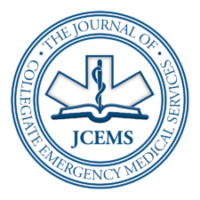Poster Presentation Abstract
Introduction: The Eckerd College Emergency Response Team (EC-ERT) often receives more than four calls within one hour. With one BLS team on call at a time, non-emergent calls were previously transferred to county ALS for transport so that EC-ERT responders could be available for additional calls. EC-ERT leadership looked to reduce unwarranted ALS transports and to provide better care to the Eckerd Community. Program Development & Implementation: EC-ERT created a program called “Continued Care” (CC) to provide a prehospital care resource for patients who required additional time to monitor their condition until care could be terminated. EC-ERT utilizes the Pinellas County EMS Cognitive Evaluation and Glascow Coma Scale to assess the patient’s mental status before and during CC. The EC-ERT office is equipped with a designated CC area, complete with a hospital bed and response gear, and has a capacity of one patient. On weekend nights, an additional team of at least two EMTs are assigned to be the CC Team, ensuring an additional team is available for response on busy nights. Protocols were implemented for utilizing CC, including when an individual can be released, what to do if a patient begins to trend downward, and how to terminate care. Program Evaluation: CC was first utilized in 2015, with 9 instances using the CC program as an extended care resource. As the number of calls received by EC-ERT has increased since the team’s founding, the number of CC instances has also increased. As a whole, the number of ALS transports decreased since CC was implemented. CC can also be utilized, if necessary, as a secondary team, with busier weekend nights bringing in as many as 22 calls within 4 hours. Discussion/Conclusion: CC allows EC-ERT responders to take more time with non-emergent patients by offering additional responders, specific protocols and resources to monitor patients for extended periods of time. Through its design and implementation, CC reduces non-emergent ALS transports, thus reducing strain on the county EMS system and local emergencies rooms. Many students also benefit from not having to pay for extensive hospital and transport fees if they are able to leave CC with improved GCS, vitals, and cognitive evaluation scores. Moving forward, EC-ERT hopes to track specific CC trends over time.








